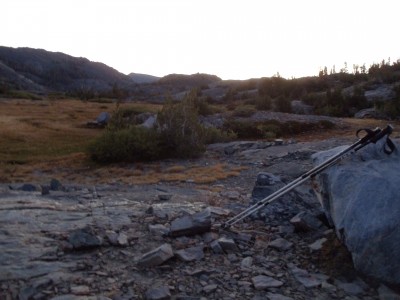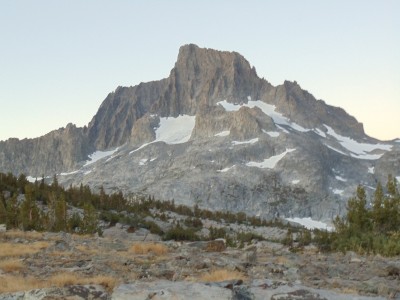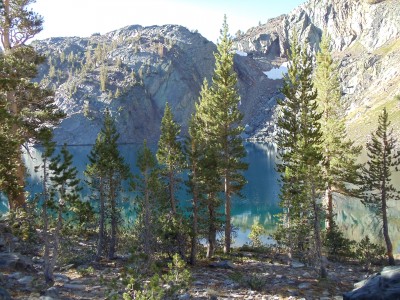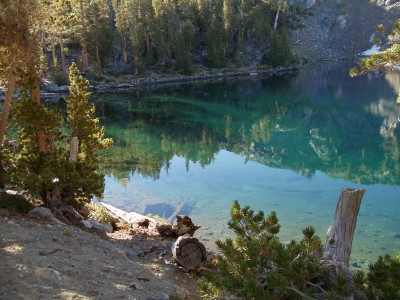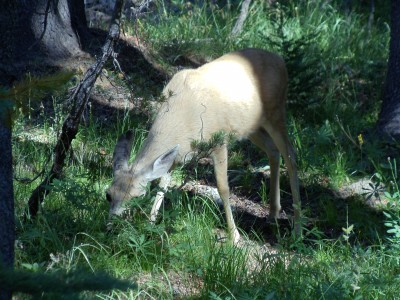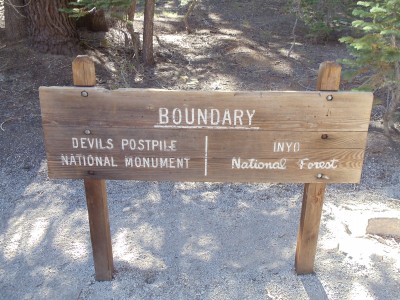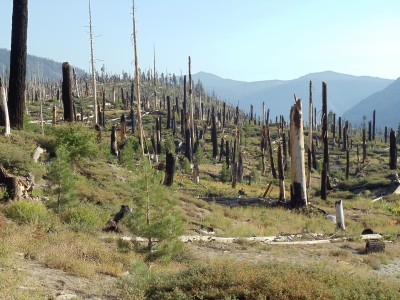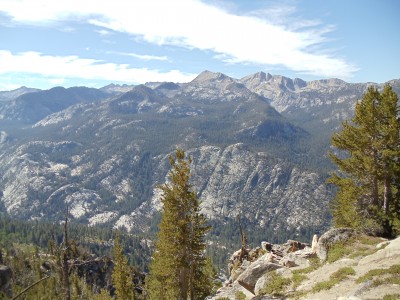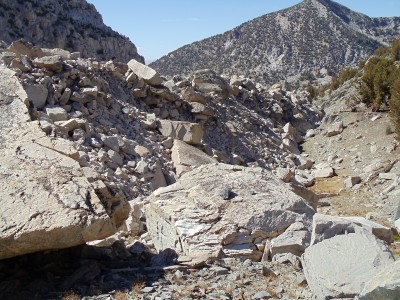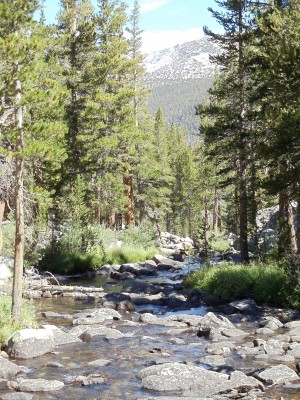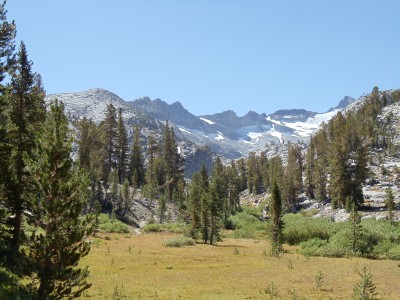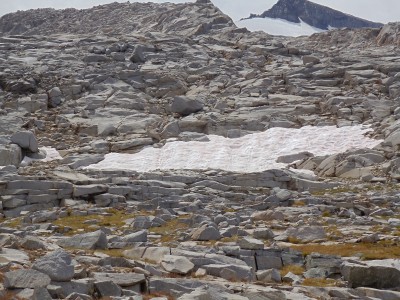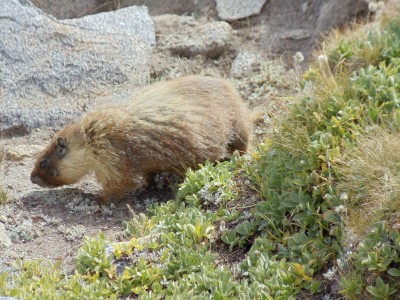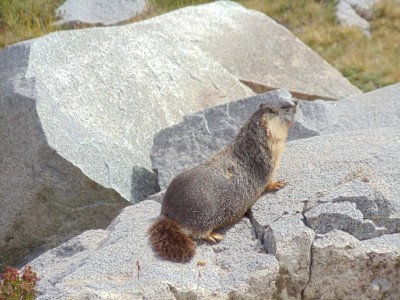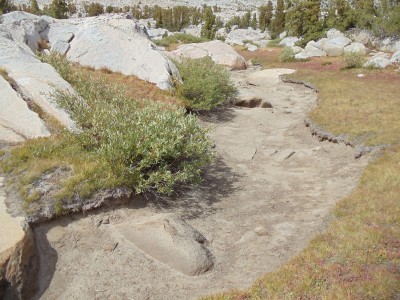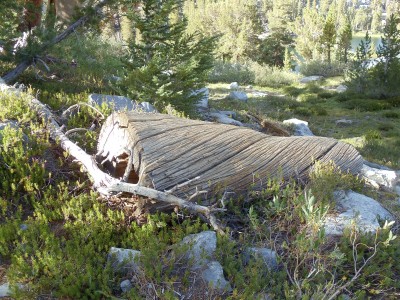September 14
(17; 0 side; 60 total, 151 to go)
As planned I wake up early enough to catch the tail end of darkness before sunrise; this being the middle of a fairly large valley, I should be able to see it unimpeded. Surprisingly, given last night, little wind blows past the lake, and it’s much more comfortable than it was or than I had expected it would be. The sunrise is excellent but blinding; my camera has some difficulty capturing both brightness of the sky and comparative darkness of the ground. Nevertheless, I take a few pictures as I huddle inside sleeping bag and bivy sack waiting for the sun to rise to provide warmth to leave them.
Hiking begins relatively early today, in accord with rising for an early sunrise. The first several miles of trail wind around several lakes named for gems, climbing up and over and down ridges along the way. Today is the fourth day of hiking, and my ankles are beginning to adjust to the inclines and constant pounding through which I’m putting them. But for now, I’m far more engrossed in enjoying the thoroughly ridiculous scenery than in feeling any lingering pain.
The largest of the precious-stone lakes, Garnet Lake, provides the greatest views. It dominates the landscape through its size, and its gently-rippling waters are a blurred mirror for the peaks in the distance behind it.
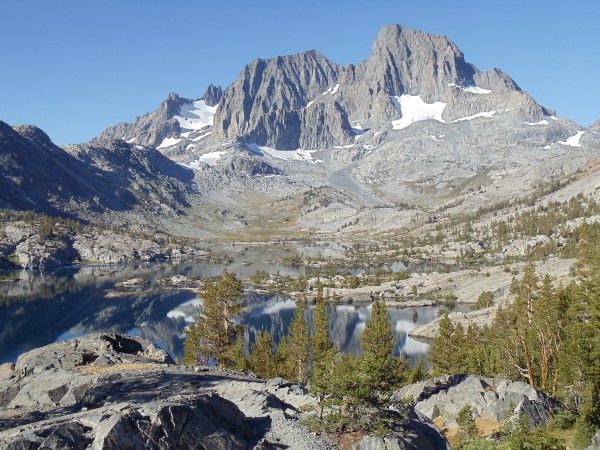
(Interestingly, my first picture of it and the mountains in the background is a near-exact copy of the cover of the guidebook I carried, even though I didn’t intend to precisely replicate the picture. [I probably aimed for the general idea — towering mountains above lake with some ground and trail in the foreground — but I didn’t notice the exact spot of that picture was mere steps away, even though I usually try to look for the settings of pictures in guidebooks I use.] The guidebook picture is obviously older, but beyond that the major difference is that my picture captures reflection in the lake while the guidebook doesn’t. I suspect it was deliberately airbrushed out of the picture to reduce busyness.)
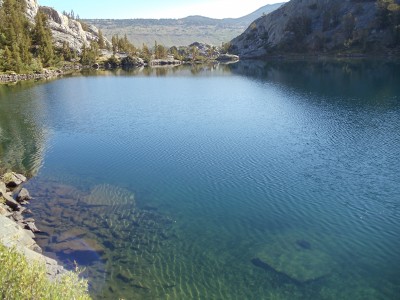
Past Garnet Lake the trail ascends out of Garnet’s bowl, then generally descends on the way toward Devils Postpile National Monument. I pass by more lakes, none of which strike me enough to merit a picture.
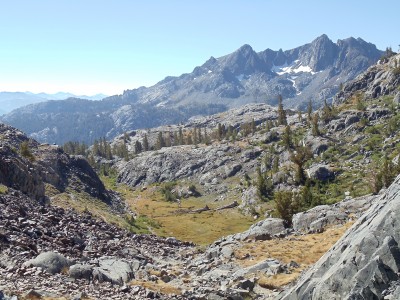
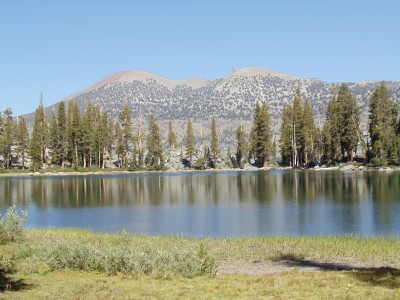
Just past one stream crossing I wander by another deer. Unlike previous deer on the JMT, this one cautiously watches me as I stop and take its picture, starting briefly at my experimental, abrupt move intended to gauge its reaction. Yet as with earlier deer, it generally ignores me. In the past I’ve considered this unnatural: wild animals should be afraid of humans, and they should retreat when humans approach. Yet this deer makes me reconsider. The primary problem with Shenandoah deer (often brazen beggars) was not their willingness to be near humans: it was their willingness to be near humans to beg. Proximity, and even some level of ease, is not inherently bad. The problem occurs when this is taken for granted: then, fearlessness and misguided beneficience produce a vicious cycle by which wildlife becomes no longer truly wild.
Shenandoah is too easily accessible for wildlife’s cautious acceptance of human presence to be workable. Throngs of visitors will to a sufficient extent ignore signs, act carelessly, and inexorably lead deer and other wildlife to mendicancy. In Shenandoah it really would be better for deer and other wildlife to be fearful of human presence to the point of fleeing it. (Bears in Shenandoah actually do this, mostly, I suspect, because SNP deals with problem bears much more aggressively than it deals with the vastly greater multitude of problem deer. Of course, bears being much more fearsome than deer also reduces interaction. 😉 )
But in many sections of the John Muir Trail, in the middle of remote wilderness, the deer that turns a wary eye in my direction yet continues about his business presents no problem. Nor does he induce any. Backpackers generally well-educated about interacting with wildlife (and usually not carrying food to spare!) won’t be much of an issue. Horseback visitors from nearby Devils Postpile are inherently hindered from over-close interaction, and they’re often supervised by informed guides. Less-educated day hikers are most problematic, but fewer of them will be here simply because it’s difficult to get to much of the JMT, severely blunting their ill effects. Complete lack of fear in wildlife is likely unworkable; it lowers barriers to interaction too far. But wildlife’s cautious acceptance along the JMT of human presence at a small distance, so long as the JMT remains remote, is a fragile yet stable equilibrium.
After much more descent I finally reach relatively flat ground: Devils Postpile National Monument is at hand. Devils Postpile’s main attraction is its bizarre natural rock formations: tall, regular hexagonal basalt columns (other sidedness less frequently) formed by volcanic action. The JMT passes through Devils Postpile’s periphery, so I’d have to detour to see the formations, partly contributing to my decision not to go see them. But more than the delay, I decide not to go because the monument feels like it’s a Pacific Crest Trail experience, not a JMT experience. If I’m not deliberately visiting Devils Postpile, I’m going to leave seeing it for when I thru-hike the PCT. (For the same reason you won’t find me hiking a section of the PCT to hike it, except as part of a thru-hike.)
I follow the trail through Devils Postpile, guided mostly by a picture I took of the map at a trail junction shortly inside it. (The guidebook strangely foregoes a map to awkwardly describe it in prose, making it less useful and more confusing than one might hope.) It’s mostly deep sand, so the going is a bit slow. Finally, I reach the turnoff to visit Reds Meadow, a campground, store, and restaurant just off-trail where I hope (likely quixotically, given the wide variety of digital cameras and batteries) to find a replacement camera battery. The meter on my camera’s been declining much more quickly than I’d expected, so I’m worried about running out partway down the trail and thus missing the end. I’m not in luck: the store has nothing more than standard batteries and regular rolls of film. I consider eating dinner at the restaurant, but I propel myself southward in hope of reaching a camping spot with some daylight. It’s now 17:00, and if I move quickly I can reach Crater Meadow in daylight.
Trail south of here turns a bit eerie as I pass through the remains of a forest fire eighteen years ago. Blackened trees are everywhere, but smaller growth abounds. The trail curves through the area before heading up into the mountains again, and I hit a solid pace as I push to the end of the day.
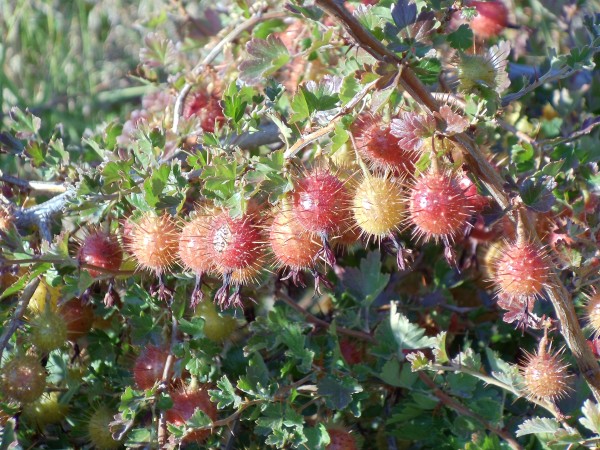
The trail leaves the burned area and starts ascending, and I notice a few decent campsites. However, having noted Crater Meadow as a goal, I feel compelled not to stop until I reach it. It starts to get dusky as I finish out the day, but I make it to a campsite near a small river crossing with light to spare and call it a day. The site’s partially occupied by Michelle, another JMT thru-hiker (albeit one starting from Tuolumne Meadows due to scheduling mishaps, hiking the entire stretch without resupply — a very aggressive pace/load that’s still not inconceivable). She’s started a small campfire, which provides for a nice break from my usual habit of not having campfires while backpacking. I eat dinner and we talk off and on as night falls.
I’m still carrying that boxed wine, but there’s a lake roughly a day’s hike from here. Maybe I can break it out tomorrow night, cool it in the lake, and finally get rid of its weight with dinner.
September 15
(18.5; 0 side; 78.5 total, 132.5 to go)
It’s up and out around the usual time this morning. Michelle and I end up leaving about the same time, but I overtake her shortly as I move faster with much less food to carry. I speed through the first six-odd miles of the day: there’s some scenery but no water, so I have little reason to stop.
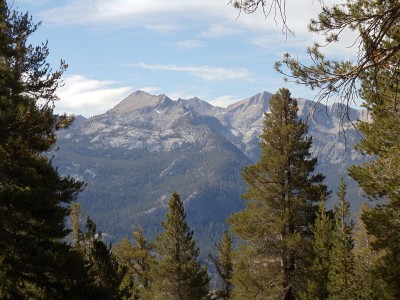
Duck Creek ends the drought, and even though it’s a little early in the day I take the opportunity and stop for lunch, Michelle passing me as I eat. Readily-available water is always good at mealtime, especially as tortillas with thick peanut butter or Nutella contain little water. I continue south again after lunch, curving around a small mountain before descending to Purple Lake. It looks like a nice camping spot, if I had reached it at the end of the day. I exchange pleasantries with a few people near the lake’s outlet, learning that Michelle is shortly ahead of me, and ascend again toward windswept Lake Virginia, passing Michelle along the way. Lake Virginia’s slopes are much flatter than those of other recent lakes, probably because it’s a larger lake.
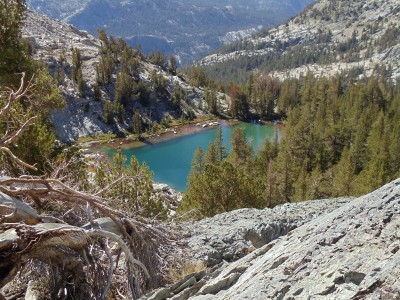
Past Lake Virginia the trail switchbacks steeply descending into Tully’s Hole, then follows a creek to a trail junction. It’s around 17:00 now, so if I move quickly and keep moving I should reach Squaw Lake a bit short of nearby Silver Pass with daylight to spare: just about perfect for lightening my pack of a liter of wine. I do so, arriving at the sublime Squaw Lake shortly after 18:00.
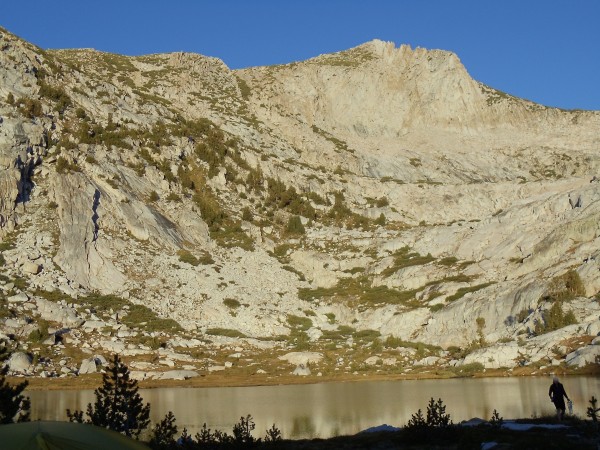
I scout around for some sort of decent campsite before settling for bare rock halfway between the lake and the trail proper. (Bivy sacks are versatile — and mine is certainly more versatile than my non-freestanding tent.) Michelle arrives and contemplates continuing to Pocket Meadow, which looks to be about five miles south (most of which she’d be traveling after dark) before deciding to stop here as well.
Dinner is scampi (Knorr pasta as always) with salmon and a splash of pinot grigio. I have no idea whether I’m significantly improving the taste, or if I’m adding the optimal amount at the correct time, but I figure I can’t go wrong (and in any case, there’s nothing wrong with the placebo effect 🙂 ). I have more than I really need to drink, so it’s painless to experiment. Michelle also takes a splash in her dinner since I have so much.
I finish off dinner, then the remaining part of the liter, as darkness falls. But it’s not dark! Entirely by accident I have scheduled my hike to occur during the moon’s waxing phase, ending a couple days into its waning phase. (I don’t believe I could have timed my hike any better if I’d tried.) The moon is large and bright in the sky, enough so that I eventually turn off my flashlight as darkness falls; I really don’t need it to see as long as I don’t have to walk around much. Once I finally finish off the wine it’s off to sleep underneath stars and moon by an alpine lake. Can it get any better than this? I am extremely hard-pressed to think how.
…but, as has happened before, this is not the end of the day! Around 03:00 I wake up to the flashlights of two hikers passing from the north. They don’t stop, perhaps recognizing a campsite with sleeping hikers when they see it, and I’m in no mood to wake up and find out why they’re hiking now, so back to sleep I go.

